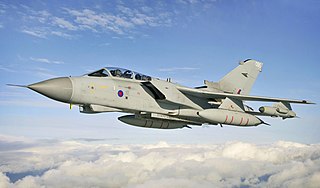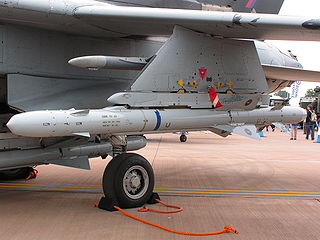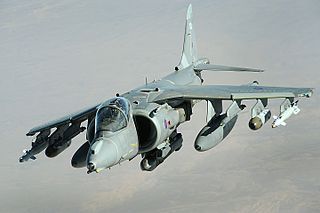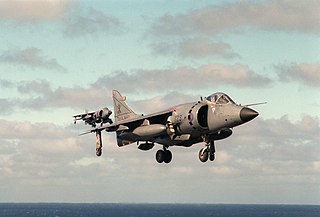
The Thermal Imaging Airborne Laser Destroyer (TIALD) was a targeting pod manufactured by Ferranti/GEC Marconi in the late 1980s and 1990s, and was the UK's primary laser designator for its Paveway series of laser-guided bombs (LGBs).

The Thermal Imaging Airborne Laser Destroyer (TIALD) was a targeting pod manufactured by Ferranti/GEC Marconi in the late 1980s and 1990s, and was the UK's primary laser designator for its Paveway series of laser-guided bombs (LGBs).
The RAF's first laser designators were Westinghouse Electric Corporation Pave Spike pods fitted to Blackburn Buccaneers which entered service in 1979. [1] However as these were limited to daylight use, the Ministry of Defence initiated studies for a new laser designator. [1] The first operational use of LGBs by the UK's armed forces were the RAF Harrier attacks on Argentine forces during the Falklands War. However, laser designation for these attacks was carried out by a forward air controller using a ground designator. [1]
In 1988 a Ferranti-led consortium was awarded a contract for development of its TIALD laser designator pod for use on the Panavia Tornado. [2] The Ferranti pod incorporated thermal imagers from GEC-Marconi and automatic video tracking equipment from British Aerospace. [2] The first use of the TIALD pod occurred during trials in May 1990 where a Buccaneer guided Paveway II bombs dropped from a Tornado. [1]
The 1990 Iraqi invasion of Kuwait saw the TIALD pod rushed into service on Tornado GR1s in just 46 days. [1] In the resultant Gulf War, two pre-production TIALD pods were used to guide 229 LGBs to their targets. [3] [4]
The TIALD pod was used extensively following the Gulf War including during the Iraqi no-fly zone patrols (1991-2003), [5] the related Operation Desert Fox (1998), [6] Operation Deliberate Force, Bosnia (1995), [7] the Kosovo War (1999) [7] and the 2003 Iraq Conflict.
In March 1995 the RAF received the first upgraded SEPECAT Jaguar aircraft capable of operating the TIALD pod. The upgrade required both hardware and software updates of the type. [8] Integration on the Harrier GR7 commenced in 1996. [9]
Due to the corporate history of its parent companies, the manufacturer of the TIALD pod has been known as Ferranti, GEC-Ferranti/GEC-Marconi, [3] BAE Systems Avionics, [10] and Selex ES. [11]
Experience in Afghanistan lead to the realisation that TIALD was outdated, as described by an RAF Wing Commander:
"[It] was designed in the 1980s, to allow pilots to drop laser guided bombs on targets like bridges, big buildings and aircraft hangars... TIALD as an air interdiction targeting pod is very good and has done this reasonably well over the last decade, as was proved in Deliberate Force (1995), Allied Force (1999), and Operation Telic (2003). Now, however, we need a sensor that is geared more towards urban [ close air support ], where we need to defend particular targets that are very similar to others, like compounds within small towns or villages." [12]
The TIALD pod was replaced by the LITENING targeting pod on Tornados. [13] The Sniper pod replaced TIALD on Harriers following an urgent operational requirement in 2007. [11] [14]
Marconi Electronic Systems (MES), or GEC-Marconi as it was until 1998, was the defence arm of General Electric Company (GEC). It was demerged from GEC and bought by British Aerospace (BAe) on 30 November 1999 to form BAE Systems. GEC then renamed itself Marconi plc.

The Eurofighter Typhoon is a European multinational twin-engine, canard delta wing, multirole fighter. The Typhoon was designed originally as an air superiority fighter and is manufactured by a consortium of Airbus, BAE Systems and Leonardo that conducts the majority of the project through a joint holding company, Eurofighter Jagdflugzeug GmbH. The NATO Eurofighter and Tornado Management Agency, representing the UK, Germany, Italy and Spain, manages the project and is the prime customer.

The Panavia Tornado is a family of twin-engine, variable-sweep wing multirole combat aircraft, jointly developed and manufactured by Italy, the United Kingdom and West Germany. There are three primary Tornado variants: the Tornado IDS (interdictor/strike) fighter-bomber, the suppression of enemy air defences Tornado ECR and the Tornado ADV interceptor aircraft.

The SEPECAT Jaguar is an Anglo-French jet attack aircraft originally used by the British Royal Air Force and the French Air Force in the close air support and nuclear strike role. It is still in service with the Indian Air Force.

Paveway is a series of laser-guided bombs (LGBs).

A laser-guided bomb (LGB) is a guided bomb that uses semi-active laser guidance to strike a designated target with greater accuracy than an unguided bomb. First developed by the United States during the Vietnam War, laser-guided bombs quickly proved their value in precision strikes of difficult point targets. These weapons use on-board electronics to track targets that are designated by laser, typically in the infrared spectrum, and adjust their glide path to accurately strike the target. Since the weapon is tracking a light signature, not the object itself, the target must be illuminated from a separate source, either by ground forces, by a pod on the attacking aircraft, or by a separate support aircraft.

ALARM is a British anti-radiation missile designed primarily to destroy enemy radars for the purpose of Suppression of Enemy Air Defenses (SEAD). It was used by the RAF and is still used by the Royal Saudi Air Force. The weapon was retired by the UK at the end of 2013.

LANTIRN is a combined navigation and targeting pod system for use on the United States Air Force fighter aircraft—the F-15E Strike Eagle and F-16 Fighting Falcon. LANTIRN significantly increases the combat effectiveness of these aircraft, allowing them to fly at low altitudes, at night and under-the-weather to attack ground targets with a variety of precision-guided weapons.

Brimstone is a ground or air-launched ground attack missile developed by MBDA UK for the UK's Royal Air Force. It was originally intended for "fire-and-forget" use against mass formations of enemy armour, using a millimetre wave (mmW) active radar homing seeker to ensure accuracy even against moving targets. Experience in Afghanistan led to the addition of laser guidance in the dual-mode Brimstone missile, allowing a "spotter" to pick out specific and the highest priority targets, particularly useful to minimise collateral damage when friendly forces or civilians were in the area. The tandem shaped-charge warhead is much more effective against modern tanks than older similar weapons such as the AGM-65G Maverick. Three Brimstones are carried on a launcher that occupies a single weapon station, allowing a single aircraft to carry many missiles.

The Euroradar Captor is a next-generation mechanical multi-mode pulse Doppler radar designed for the Eurofighter Typhoon. Development of Captor led to the Airborne Multirole Solid State Active Array Radar (AMSAR) project which eventually produced the CAESAR, now known as Captor-E.

The British Aerospace Harrier II is a second-generation vertical/short takeoff and landing (V/STOL) jet aircraft used previously by the Royal Air Force (RAF) and, between 2006 and 2010, the Royal Navy (RN). The aircraft was the latest development of the Harrier Jump Jet family, and was derived from the McDonnell Douglas AV-8B Harrier II. Initial deliveries of the Harrier II were designated in service as Harrier GR5; subsequently upgraded airframes were redesignated accordingly as GR7 and GR9.

Number 12 Squadron, also known as No. 12 (Bomber) Squadron and occasionally as No. XII Squadron, is a flying squadron of the Royal Air Force (RAF). The squadron reformed in July 2018 as a joint RAF/Qatari Emri Air Force squadron. It is currently based at RAF Coningsby, Lincolnshire, and operates the Eurofighter Typhoon FGR4, while temporarily integrating Qatari air and ground crews in order to provide training and support as part of the Qatari purchase of 24 Typhoons from the UK.

The Lockheed Martin Sniper is a targeting pod for military aircraft that provides positive target identification, autonomous tracking, GPS coordinate generation, and precise weapons guidance from extended standoff ranges.

Ferranti or Ferranti International plc was a UK electrical engineering and equipment firm that operated for over a century from 1885 until it went bankrupt in 1993. The company was once a constituent of the FTSE 100 Index.

A guided bomb is a precision-guided munition designed to achieve a smaller circular error probable (CEP).

This is a list of the units, aircraft and casualties of the British air services in the Falklands War. The numbers in bold are the number of aircraft used in the war, the numbers in brackets are the number of lost aircraft. For a list of air forces from Argentina, see Argentine air forces in the Falklands War.
FILAT pod is an airborne targeting pod designed to provide aircraft with all weather / night attack capabilities. It was first revealed to the public at 1998 Zhuhai Air Show, and it is designed by the 613 Institute of AVIC.
LT PGB is an abbreviation for a family of Chinese built precision guided munitions named Fury Precision Guided Bomb developed by Luoyang Electro-Optics Technology Development Centre (EOTDC), a subsidiary of China Aerospace Science and Technology Corporation (CASC). Alternatively, LT PGB is also referred by its laser guidance, as Fury laser-guided bomb, or LT LGB.
The ARI.23246/1 Sky Shadow is a radar jamming system, initially developed by GEC-Marconi Defence Systems, formerly operated by the Royal Air Force (RAF).
{{cite journal}}: Cite journal requires |journal= (help)